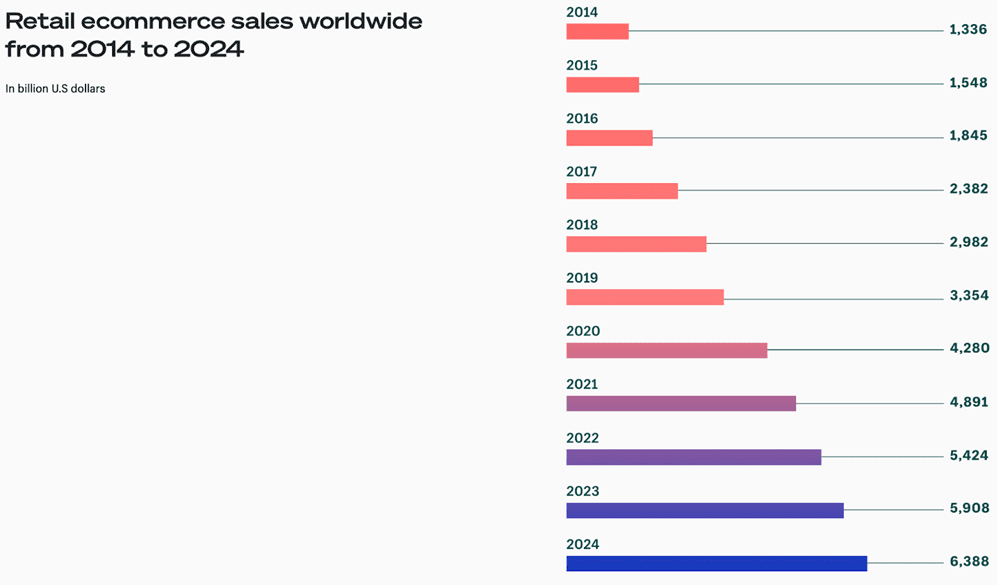The ecommerce industry is booming. While the pandemic accelerated the need for businesses to digitalize, advancements in technology and the surge in available marketplaces also helped ease buying and selling online.
According to Shopify, the ecommerce industry is expected to grow by almost $11 trillion by 2025. Online stores are popping up every day – with an estimated 12-24 million ecommerce sites globally.
And according to Statista, retail e-commerce sales amounted to approximately $5.2 trillion worldwide in 2021 alone. This figure is forecast to grow by 56% over the next years, reaching $8.1 trillion by 2026.
What Are the Key Ecommerce Trends Behind This Growth?
A few key ecommerce trends are emerging in 2022 and beyond.
1. Direct-to-consumer competition is increasing
Ecommerce sales have not slowed with the reopening of brick-and-mortar stores. Hence, there has been an influx of direct-to-consumer brands and a significant increase in competition. And as more businesses are online, it’s harder to be found by new customers.
2. Advertising costs are increasing across the board
Digital advertising costs are skyrocketing and putting pressure on marketing-heavy customer acquisition models. The cost per click for paid search ads increased by 15% between the second and third quarters of 2021 alone.
Additionally, the Apple iOS 14 release has also made it more difficult to track the impact of ad spend.
3. Brand building is emerging as the key to attracting and retaining customers
To attract and retain consumers, brands must be authentic, socially responsible, and consistent. Plus, they must stay on top of social ecommerce trends, which are at the center of online shopping.
According to Accenture, 52% of consumers are more likely to purchase from a company with shared values. And in 2022, 53% of brands are creating products that align with their values.
Source: Accenture
The 5 Steps You Can Take to Improve Your Shopify Adoption
Whether you are just getting started on Shopify or are already there and want to optimize the opportunity ahead, applying these emerging ecommerce trends to your business will prove critical to your long-term success.
1. Understand your target audience
Before you take any other steps, make sure you perfectly understand who you are selling to. Understanding your target market can help guide you on which distribution channels to prioritize, what new products to add to your portfolio, how to position and market your brand, and more.
And to get there, consider conducting consumer surveys. Leverage metrics such as NPS, brand awareness and perception, or purchase intent.
2. Set up an omnichannel distribution and marketing approach
Diversify your customer reach by setting up additional distribution channels. Take your single Shopify online store and then sell across all relevant distribution touchpoints – web, mobile, in-person, social media, online marketplaces, pop-up stores, and even brick-and-mortar stores.
In particular, pay close attention to your social media channels. Sales through these channels are projected to nearly triple by 2025. And consider video or live chat to make your social channels more engaging. Also, make sure your content is “shoppable.” Create the right checkout moments during your livestream shopping events.
Once you have your different distribution channels set up, optimize your campaigns across all of them. Use Shopify’s Admin panel to create, run, and optimize your marketing efforts. Also, get insights into which products, images and messaging resonate best with your target audience.
3. Prioritize sales over admin work
To focus on the bread and butter of your business – marketing and sales – leverage Spotify’s back-end tools to automate as much of the admin work as possible. For example, use Shopify’s Back Office to manage fulfillment, inventory, and shipping. Plus, use Shopify’s banking and payment solutions to manage your money and funding, allow customers to pay, or let them split payments into installments.
4. Customize your business based on your customers’ unique needs
While Shopify’s core product gets you started with everything you need to turn your idea or product into sales, the platform offers additional tools to help you customize, upgrade and differentiate your business.
Explore Shopify’s add-on services and tools, such as easier access to capital or accelerated payment options.
Moreover, leverage Shopify’s App Store for 9,000+ third-party apps and features, including an SMS app, virtual try-ons, or new social media network ad tools. And if you can’t find exactly what you’re looking for, you can always hire a Shopify expert to build custom solutions for your business.
Lastly, explore Shopify’s custom storefronts or the option of “going headless.” Shopify lets you build shopping experiences anywhere – from video games to smart mirrors – with custom storefronts. In turn, this headless architecture separates your front-end storefronts from your back-end tech stack, giving you more control over your consumer and developer experience.
5. Monitor and action your analytics
Make sure to monitor your sites and social media channels on an ongoing basis. Track metrics such as traffic, social engagement, or search engine optimization (SEO). Then use these insights to make changes to your products, positioning, or point of sale.
And as new privacy laws complicate product personalization efforts, consider turning to first-party data (i.e. the data you collect directly from the consumer, with their consent of course). Quizzes or first-party behavioral data can serve as excellent input into product personalization efforts.
How Germain UX Can Help With Your Shopify Adoption
Germain UX recently rolled out its Real User Experience Monitoring Insights and User Replay features to Shopify.
You can now integrate Germain UX into your Shopify ecommerce site and start improving your User Experience via our real-time user monitoring automation, alerts, and insights. Check our new wizard here or get in touch with our team (info @ germainux . com) so we can set this up for you or interested in learning more.
Conclusion
Shopify’s all-in-one commerce platform has made it easier for both newcomers and legacy brands to start and scale their businesses globally. Shopify now boasts over a million independent businesses, merchants across 175 countries, and $444 billion in global economic activity.
However, the increase in ease is complemented by an increase in competition. Retail commerce sales are projected to skyrocket from $1.3 billion in 2014 to $6.4 billion in 2024.
Source: Statista
So to help your products stand out and grow, make sure you follow the latest ecommerce trends and apply them to your business. Utilize all of Shopify’s helpful tools and resources to help you prioritize your customer lifetime value, brand loyalty, and trust. There’s a reason why the world’s leading companies have brand building at the core of their marketing strategies in 2022.





